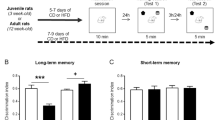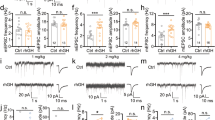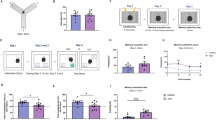Abstract
The gut hormone and neuropeptide ghrelin affects energy balance and growth hormone release through hypothalamic action that involves synaptic plasticity in the melanocortin system. Ghrelin binding is also present in other brain areas, including the telencephalon, where its function remains elusive. Here we report that circulating ghrelin enters the hippocampus and binds to neurons of the hippocampal formation, where it promotes dendritic spine synapse formation and generation of long-term potentiation. These ghrelin-induced synaptic changes are paralleled by enhanced spatial learning and memory. Targeted disruption of the gene that encodes ghrelin resulted in decreased numbers of spine synapses in the CA1 region and impaired performance of mice in behavioral memory testing, both of which were rapidly reversed by ghrelin administration. Our observations reveal an endogenous function of ghrelin that links metabolic control with higher brain functions and suggest novel therapeutic strategies to enhance learning and memory processes.
This is a preview of subscription content, access via your institution
Access options
Subscribe to this journal
Receive 12 print issues and online access
$209.00 per year
only $17.42 per issue
Buy this article
- Purchase on Springer Link
- Instant access to full article PDF
Prices may be subject to local taxes which are calculated during checkout






Similar content being viewed by others
References
Kojima, M., Hosoda, H., Date, Y., Nakazato, M. & Kangawa, K. Ghrelin is a growth-hormone-releasing acylated peptide from stomach. Nature 402, 656–660 (1999).
Tschop, M., Smiley, D.L. & Heiman, M.L. Ghrelin induces adiposity in rodents. Nature 407, 908–913 (2000).
van der Lely, A.J., Tschop, M., Heiman, M.L. & Ghigo, E. Biological, physiological, pathophysiological, and pharmacological aspects of ghrelin. Endocr. Rev. 25, 426–457 (2004).
Horvath, T.L., Castañeda, T., Tang-Christensen, M., Pagotto, U. & Tschop, M.H. Ghrelin as a potential anti-obesity target. Curr. Pharm. Des. 9, 1383–1395 (2003).
Kojima, M. & Kangawa, K. Ghrelin: structure and function. Physiol. Rev. 85, 495–522 (2005).
Guan, X.M. et al. Distribution of mRNA encoding the growth hormone secretagogue receptor in brain and peripheral tissues. Brain Res. Mol. Brain Res. 48, 23–29 (1997).
Mitchell, V. et al. Comparative distribution of mRNA encoding the growth hormone secretagogue-receptor (GHS-R) in Microcebus murinus (Primate, lemurian) and rat forebrain and pituitary. J. Comp. Neurol. 429, 469–489 (2001).
Cowley, M.A. et al. The distribution and mechanism of action of ghrelin in the CNS demonstrates a novel hypothalamic circuit regulating energy homeostasis. Neuron 37, 649–661 (2003).
Pinto, S. et al. Rapid rewiring of arcuate nucleus feeding circuits by leptin. Science 304, 110–115 (2004).
Banks, W.A., Tschop, M., Robinson, S.M. & Heiman, M.L. Extent and direction of ghrelin transport across the blood-brain barrier is determined by its unique primary structure. J. Pharmacol. Exp. Ther. 302, 822–827 (2002).
Wortley, K.E. et al. Absence of ghrelin protects against early-onset obesity. J. Clin. Invest. 115, 3573–3578 (2005).
Seyler, D.E. et al. Effect of growth hormone secretagogue LY444711 on IGF-1, growth hormone, and cortisol levels in beagle dogs after one and seven daily oral doses. Drug Dev. Res. 49, 260–265 (2000).
Sarter, M., Bodewitz, G. & Stephens, D.N. Attenuation of scopolamine-induced impairment of spontaneous alteration behaviour by antagonist but not inverse agonist and agonist beta-carbolines. Psychopharmacology (Berl.) 94, 491–495 (1988).
Ragozzino, M.E., Parker, M.E. & Gold, P.E. Spontaneous alternation and inhibitory avoidance impairments with morphine injections into the medial septum. Attenuation by glucose administration. Brain Res. 597, 241–249 (1992).
Ragozzino, M.E., Wenk, G.L. & Gold, P.E. Glucose attenuates a morphine-induced decrease in hippocampal acetylcholine output: an in vivo microdialysis study in rats. Brain Res. 655, 77–82 (1994).
McNay, E.C., Fries, T.M. & Gold, P.E. Decreases in rat extracellular hippocampal glucose concentration associated with cognitive demand during a spatial task. Proc. Natl. Acad. Sci. USA 97, 2881–2885 (2000).
McNay, E.C., McCarty, R.C. & Gold, P.E. Fluctuations in brain glucose concentration during behavioral testing: dissociations between brain areas and between brain and blood. Neurobiol. Learn. Mem. 75, 325–337 (2001).
Bostock, E., Gallagher, M. & King, R.A. Effects of opioid microinjections into the medial septal area on spatial memory in rats. Behav. Neurosci. 102, 643–652 (1988).
Ragozzino, M.E. & Gold, P.E. Glucose injections into the medial septum reverse the effects of intraseptal morphine infusions on hippocampal acetylcholine output and memory. Neuroscience 68, 981–988 (1995).
Ragozzino, M.E., Hellems, K., Lennartz, R.C. & Gold, P.E. Pyruvate infusions into the septal area attenuate spontaneous alternation impairments induced by intraseptal morphine injections. Behav. Neurosci. 109, 1074–1080 (1995).
Wan, R.Q., Givens, B.S. & Olton, D.S. Opioid modulation of working memory: intraseptal, but not intraamygdaloid, infusions of beta-endorphin impair performance in spatial alternation. Neurobiol. Learn. Mem. 63, 74–86 (1995).
McNay, E.C. & Gold, P.E. Memory modulation across neural systems: intra-amygdala glucose reverses deficits caused by intraseptal morphine on a spatial task but not on an aversive task. J. Neurosci. 18, 3853–3858 (1998).
Talley, C.P., Arankowsky-Sandoval, G., McCarty, R. & Gold, P.E. Attenuation of morphine-induced behavioral changes in rodents by D- and L-glucose. Neurobiol. Learn. Mem. 71, 62–79 (1999).
McNay, E.C. & Gold, P.E. Age-related differences in hippocampal extracellular fluid glucose concentration during behavioral testing and following systemic glucose administration. J. Gerontol. A Biol. Sci. Med. Sci. 56, B66–B71 (2001).
Morley, J.E. et al. Beta-amyloid precursor polypeptide in SAMP8 mice affects learning and memory. Peptides 21, 1761–1767 (2000).
Myhrer, T. Exploratory behavior and reaction to novelty in rats with hippocampal perforant path systems disrupted. Behav. Neurosci. 102, 356–362 (1988).
Reed, J.M. & Squire, L.R. Impaired recognition memory in patients with lesions limited to the hippocampal formation. Behav. Neurosci. 111, 667–675 (1997).
van der Lely, A.J., Tschop, M., Heiman, M.L. & Ghigo, E. Biological, physiological, pathophysiological, and pharmacological aspects of ghrelin. Endocr. Rev. 25, 426–457 (2004).
Cummings, D.E. et al. A preprandial rise in plasma ghrelin levels suggests a role in meal initiation in humans. Diabetes 50, 1714–1719 (2001).
Horvath, T.L., Diano, S., Sotonyi, P., Heiman, M. & Tschop, M. Minireview: ghrelin and the regulation of energy balance–a hypothalamic perspective. Endocrinology 142, 4163–4169 (2001).
Grove, K.L. & Cowley, M.A. Is ghrelin a signal for the development of metabolic systems? J. Clin. Invest. 115, 3393–3397 (2005).
Burgess, N., Maguire, E.A. & O'Keefe, J. The human hippocampus and spatial and episodic memory. Neuron 35, 625–641 (2002).
Li, C. et al. Estrogen alters hippocampal dendritic spine shape and enhances synaptic protein immunoreactivity and spatial memory in female mice. Proc. Natl. Acad. Sci. USA 101, 2185–2190 (2004).
Zigman, J.M. et al. Mice lacking ghrelin receptors resist the development of diet-induced obesity. J. Clin. Invest. 115, 3564–3572 (2005).
Wu, A., Molteni, R., Ying, Z. & Gomez-Pinilla, F. A saturated-fat diet aggravates the outcome of traumatic brain injury on hippocampal plasticity and cognitive function by reducing brain-derived neurotrophic factor. Neuroscience 119, 365–375 (2003).
Rigamonti, A.E. et al. Plasma ghrelin concentrations in elderly subjects: comparison with anorexic and obese patients. J. Endocrinol. 175, R1–R5 (2002).
Tschop, M. et al. Circulating ghrelin levels are decreased in human obesity. Diabetes 50, 707–709 (2001).
Gustafson, D., Rothenberg, E., Blennow, K., Steen, B. & Skoog, I. An 18-year follow-up of overweight and risk of Alzheimer disease. Arch. Intern. Med. 163, 1524–1528 (2003).
Wortley, K.E. et al. Genetic deletion of ghrelin does not decrease food intake but influences metabolic fuel preference. Proc. Natl. Acad. Sci. USA 101, 8227–8232 (2004).
Valenzuela, D.M. et al. High-throughput engineering of the mouse genome coupled with high-resolution expression analysis. Nat. Biotechnol. 21, 652–659 (2003).
Glowinski, J. & Iversen, L.L. Regional studies of catecholamines in the rat brain. I. The disposition of [3H]norepinephrine, [3H]dopamine and [3H]dopa in various regions of the brain. J. Neurochem. 13, 655–669 (1966).
Thio, L.L., Wong, M. & Yamada, K.A. Ketone bodies do not directly alter excitatory or inhibitory hippocampal synaptic transmission. Neurology 54, 325–331 (2000).
Farr, S.A., Banks, W.A., La Scola, M.E., Flood, J.F. & Morley, J.E. Permanent and temporary inactivation of the hippocampus impairs T-maze footshock avoidance acquisition and retention. Brain Res. 872, 242–249 (2000).
Acknowledgements
The authors thank M. Shanabrough for technical assistance and editing of the manuscript and E. Borok for the electron microscopic analyses. This work was supported by grants from the US National Institutes of Health (DK60711, DK61619, NS40525, AG22880, DK70039, NS41725, DK7386, DK70039 and AA12743) and a VA Merit Review grant.
Author information
Authors and Affiliations
Corresponding author
Ethics declarations
Competing interests
The authors declare no competing financial interests.
Supplementary information
Supplementary Figure 1
Illustration of unbiased spine synapse quantification on electron micrographs. (PDF 484 kb)
Rights and permissions
About this article
Cite this article
Diano, S., Farr, S., Benoit, S. et al. Ghrelin controls hippocampal spine synapse density and memory performance. Nat Neurosci 9, 381–388 (2006). https://doi.org/10.1038/nn1656
Received:
Accepted:
Published:
Issue Date:
DOI: https://doi.org/10.1038/nn1656
This article is cited by
-
The intersection between ghrelin, metabolism and circadian rhythms
Nature Reviews Endocrinology (2024)
-
Ghrelin signaling in the cerebellar cortex enhances GABAergic transmission onto Purkinje cells
Scientific Reports (2023)
-
Ghrelin infusion into the basolateral amygdala suppresses CTA memory formation in rats via the PI3K/Akt/mTOR and PLC/PKC signaling pathways
Acta Pharmacologica Sinica (2022)
-
Intestinal Flora Affect Alzheimer's Disease by Regulating Endogenous Hormones
Neurochemical Research (2022)
-
A Giant in Geriatrics: A Tribute to Professor John Edward Morley
The Journal of nutrition, health and aging (2022)



